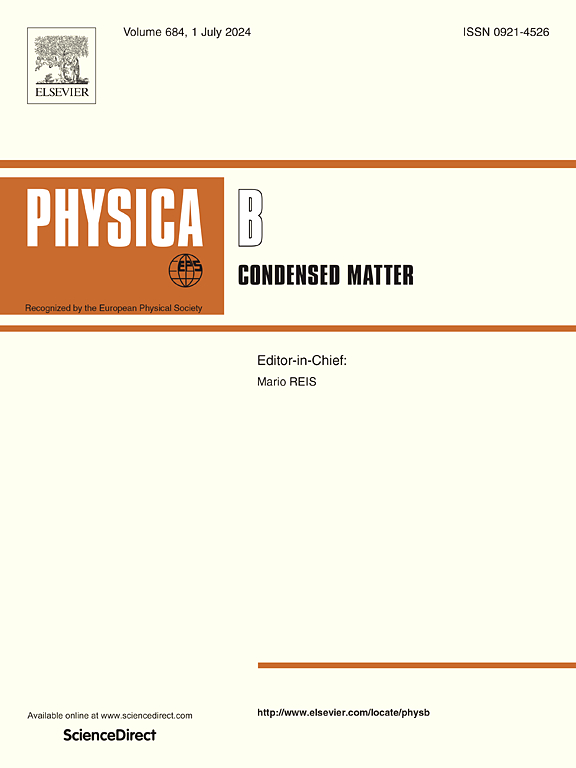Optical limiting and two-photon absorption in transition metal and rare earth-doped CeO2 nanoparticles
IF 2.8
3区 物理与天体物理
Q2 PHYSICS, CONDENSED MATTER
引用次数: 0
Abstract
CeO2(Cerium Oxide), CeO2: Cu, CeO2: Zn, CeO2: Co, CeO2: Ag and CeO2: Eu nanoparticles at 11 mol% concentration are synthesized by solution combustion method using Aloe vera gel extract as a green reducing agent. The as-formed samples are calcined at 600 °C for 3 h. Bragg reflections of CeO2 confirms the formation of cubic fluorite structure. No such additional phases/diffraction peaks corresponding to the dopant are observed. The crystallite size calculated from Scherrer’s method varies from 20 to 10 nm respectively. The energy band gap was tuned from 2.2 eV to 3.5 eV . The optical nonlinearity of the specimens was studied using the open aperture Z-scan technique, revealing reverse saturable absorption attributed to a two-photon absorption process. The non linear nonlinear non-linear absorption coefficient of C, C–Ag, C–Cu, C–Co, C–Eu, and C–Zn were found to be 0.60, 0.74, 1.40, 1.25, 0.6,1, and 0.68 respectively. The optical limiting threshold were found to be 4.27, 3.09, 1.22, 1.55, 4.03, and 3.80 x 1012 Wm−2. A higher non-linear absorption coefficient and lower limiting threshold indicate better optical limiting action. A higher E enhances defect-mediated transitions, strengthening nonlinear absorption () and lowering the optical limiting threshold (OLT), though excessive E may introduce scattering losses. Optimizing the bandgap (E) through controlled doping facilitates multiphoton absorption, enhancing and minimizing OLT for advanced NLO applications. Urbach energy analysis reveals tunable structural properties in CeO-based materials, with CeO-Zn exhibiting the lowest Urbach energy (0.28858 eV), reflecting high crystallinity. In contrast, CeO-Ag and CeO-Cu show higher values (5.19454 eV and 3.76634 eV), suggesting significant structural disorder and potential for enhanced NLO(non-linear optics) performance. Overall, the C–Cu sample emerges as an ideal material for fabricating optical limiters designed for green lasers.
过渡金属和稀土掺杂CeO2纳米粒子的光限制和双光子吸收
以芦荟凝胶提取物为绿色还原剂,采用溶液燃烧法合成了浓度为11 mol%的CeO2(氧化铈)、CeO2: Cu、CeO2: Zn、CeO2: Co、CeO2: Ag和CeO2: Eu纳米颗粒。形成的样品在600℃下煅烧3 h, CeO2的布拉格反射证实了立方氟石结构的形成。没有观察到与掺杂相对应的附加相/衍射峰。用Scherrer的方法计算得到的晶体尺寸分别为20 ~ 10 nm。能隙由2.2 eV调至3.5 eV。利用开放孔径z扫描技术研究了样品的光学非线性,揭示了双光子吸收过程的反向饱和吸收。C、C - ag、C - cu、C - co、C - eu和C - zn的非线性非线性吸收系数分别为0.60、0.74、1.40、1.25、0.6、1和0.68。光限阈值分别为4.27、3.09、1.22、1.55、4.03和3.80 × 1012 Wm−2。较高的非线性吸收系数和较低的限制阈值表明较好的光学限制作用。较高的ΔEU增强了缺陷介导的跃迁,增强了非线性吸收(β)并降低了光极限阈值(OLT),尽管过高的ΔEU可能会引入散射损失。通过控制掺杂优化带隙(ΔEg)促进多光子吸收,增强β和最小化OLT,用于先进的NLO应用。Urbach能分析表明,ceo2基材料具有可调的结构特性,其中CeO2-Zn的Urbach能最低(0.28858 eV),反映出较高的结晶度。相比之下,CeO2-Ag和CeO2-Cu表现出更高的值(5.19454 eV和3.76634 eV),表明存在明显的结构无序性和增强NLO(非线性光学)性能的潜力。总体而言,C-Cu样品成为制造绿色激光器光学限制器的理想材料。
本文章由计算机程序翻译,如有差异,请以英文原文为准。
求助全文
约1分钟内获得全文
求助全文
来源期刊

Physica B-condensed Matter
物理-物理:凝聚态物理
CiteScore
4.90
自引率
7.10%
发文量
703
审稿时长
44 days
期刊介绍:
Physica B: Condensed Matter comprises all condensed matter and material physics that involve theoretical, computational and experimental work.
Papers should contain further developments and a proper discussion on the physics of experimental or theoretical results in one of the following areas:
-Magnetism
-Materials physics
-Nanostructures and nanomaterials
-Optics and optical materials
-Quantum materials
-Semiconductors
-Strongly correlated systems
-Superconductivity
-Surfaces and interfaces
 求助内容:
求助内容: 应助结果提醒方式:
应助结果提醒方式:


